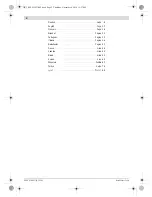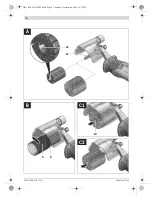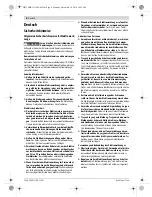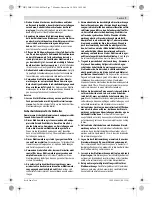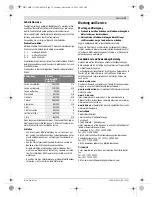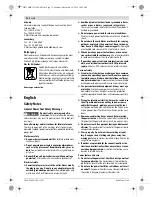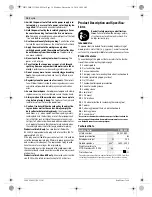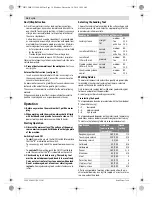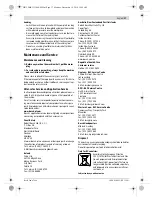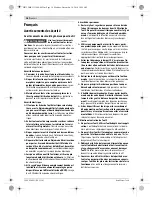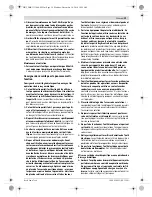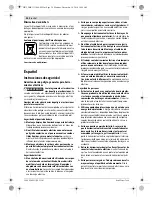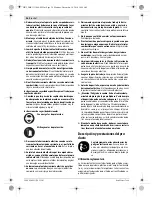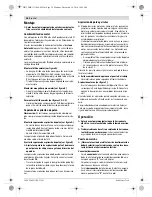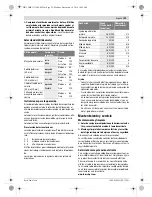
14
| English
1 609 92A 0VJ | (10.11.14)
Bosch Power Tools
Switch the power tool off when the power supply is in-
terrupted, e.g. as a result of a power cut or the plug be-
ing pulled.
This prevents an uncontrolled restart.
Hold the power tool by the insulated gripping surfaces
because the sanding tool can strike its own mains ca-
ble.
Damaging a live cable can make metal parts of the tool
“live” and lead to an electric shock.
Use the machine only for dry sanding.
Penetration of wa-
ter into the machine increases the risk of an electric shock.
Apply the machine to the workpiece only when
switched on and switch the machine off only after it has
been lifted away from the workpiece.
The power tool
can move suddenly.
Never touch the sanding tool when it is running.
This
poses a risk of injury.
Pay attention that no persons are put at risk through
sparking. Remove any combustible materials in the vi-
cinity.
Sparking occurs when sanding metal materials.
Do not use any worn, torn or severely clogged sanding
tools.
Damaged sanding tools can tear, fly off and injure
someone.
Regularly clean the power tool’s air vents.
The motor’s
fan will draw the dust inside the housing and excessive ac-
cumulation of powdered metal may cause electrical haz-
ards.
Secure the workpiece.
A workpiece clamped with clamp-
ing devices or in a vice is held more secure than by hand.
Always wait until the machine has come to a complete
stop before placing it down.
The tool insert can jam and
lead to loss of control over the power tool.
Caution, fire hazard! Avoid overheating the object be-
ing sanded as well as the sander. Always empty the
dust collector before taking breaks.
In unfavourable
conditions, e. g., when sparks emit from sanding metals,
sanding debris in the dust bag, micro filter or paper sack
(or in the filter sack or filter of the vacuum cleaner) can
self-ignite. Particularly when mixed with remainders of var-
nish, polyurethane or other chemical materials and when
the sanding debris is hot after long periods of working.
Products sold in GB only
: Your product is fitted with a
BS 1363/A approved electric plug with internal fuse (ASTA
approved to BS 1362).
If the plug is not suitable for your socket outlets, it should be
cut off and an appropriate plug fitted in its place by an author-
ised customer service agent. The replacement plug should
have the same fuse rating as the original plug.
The severed plug must be disposed of to avoid a possible
shock hazard and should never be inserted into a mains sock-
et elsewhere.
Products sold in AUS and NZ only
: Use a residual current de-
vice (RCD) with a rated residual current of 30 mA or less.
Product Description and Specifica-
tions
Read all safety warnings and all instruc-
tions.
Failure to follow the warnings and in-
structions may result in electric shock, fire
and/or serious injury.
Intended Use
The power tool is intended for dry sanding and brushing of
wood, plastic, metal, filler (e.g., gypsum), as well as coated
surfaces. It is especially suitable for sanding uneven surfaces.
Product Features
The numbering of the product features refers to the illustra-
tion of the machine on the graphics page.
1
Sander spindle
2
Dust extraction hood
3
Vacuum connection
4
Clamping screw for mounting the dust extraction hood
5
Handle (insulated gripping surface)
6
On/Off switch
7
Thumbwheel for speed preselection
8
Shank for sanding sleeve
9
Sanding sleeve
10
Lamella roll
11
SDS mount
12
SDS interface
13
SDS actuator button for unlocking the sanding tool
14
Tool arm
15
Fastening groove of the dust extraction hood
16
Latching groove
17
Vacuum hose*
*Accessories shown or described are not part of the standard de-
livery scope of the product. A complete overview of accessories
can be found in our accessories program.
Technical Data
Sanding Roller
PRR 250 ES
Article number
3 603 CB5 0..
Speed preselection
Rated power input
W
250
No-load speed n
0
min
-1
1600–3000
Weight according to
EPTA-Procedure 01/2003
kg
1.3
Protection class
/
II
The values given are valid for a nominal voltage [U] of 230 V. For differ-
ent voltages and models for specific countries, these values can vary.
OBJ_DOKU-33448-002.fm Page 14 Monday, November 10, 2014 10:59 AM


